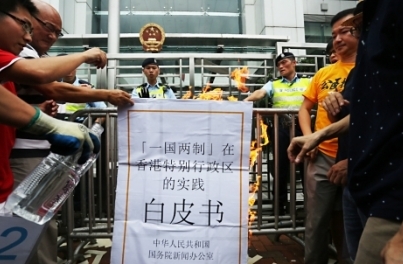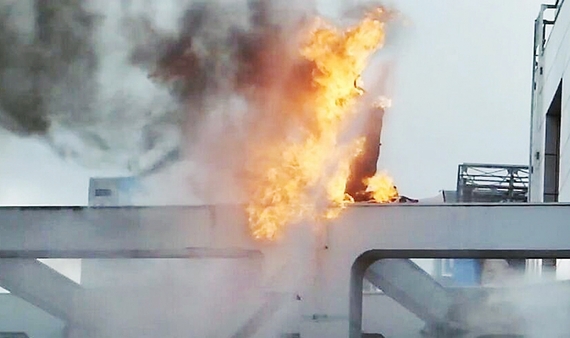In 2004, an influential law review article explored the role of fire-related metaphors in U.S. constitutional law. According to Robert Tsai's, "Fire, Metaphor, and Constitutional Myth-Making," it was possible to track meaningful transformations of the imagery used by courts to conceptualize important First Amendment issues.
From Oliver Wendell Holmes' famous 1919 "fire in a crowded theatre" rule on down, judicial decisions on free speech made use of analogies to flames and burning to define the outer limits of acceptable self-expression, or its policing. The U.S. Supreme Court in one important 1992 case even reaffirmed the First Amendment's protections of abhorrent speech, in that case the rights of Ku Klux Klansmen to publicly burn crosses, arguing that passing laws to ban such expression risked "adding the First Amendment to the fire."
All of which is to say that, regardless of which way these decisions came out, the one consistent note was that fire was a useful symbol of everything that law and order--or public discourse--wasn't. Whether because of civil disorder or an excessively overbearing government, the flames came in where communication shut down.
The same could be said for constitutional battles underway in China and Japan, where a series of unconnected developments in each country have pushed "burning" issues of legal interpretation to Asia's political center stage. Yet what's at stake goes beyond speech per se, to question the basic reach of sovereign power. In each case, fundamental disagreements have led to serious breakdowns in political discourse.
Political Representation
The most intense ongoing conflict is probably the one centered on Hong Kong's dramatic recent protest movement calling for open nominations in the general elections that are scheduled to take place in 2017. Chinese central authorities have said that they still stand by the plan for a general election (under the current system, fewer than two thousand special electors vote for Hong Kong's chief executive). But Beijing wants to keep control over the nomination process. In other words, voters will have to chose among a narrow field of pro-Beijing candidates.
The outrage over that plan led to a massive and unprecedented unofficial referendum, where Hong Kong civil society groups tried to get as much of the populace as possible to back various counter-proposals demanding the right to popular nominations. That vote garnered nearly 800,000 participants, and has raised the ongoing election struggle with Beijing into a new level of intensity.
One of the key moments in the conflict, however, was when Chinese central authorities decided to respond to liberals' demands by issuing their own official "White Paper", outlining Chinese central authorities' interpretation of Hong Kong's Basic Law (in effect, the territory's constitution). The White Paper did nothing to calm dissent, instead inflaming it by aggressively asserting Beijing's leading role in Hong Kong politics. It almost certainly helped raise participation in the protest vote.
The photo at the top of this post shows Hong Kong democracy activists setting fire to the White Paper during recent demonstrations. The stance adopted by Beijing in the document has become an unbridgeable gap between the two sides--either the Chinese official position changes, or activists will "make Hong Kong ungovernable." Some are now even voicing concerns that 1989-style repression may be inevitable.
Voiceless Minorities
Beyond the most recent headlines, however, the longest running and most intractable conflicts over legal interpretation are without doubt those affecting China's many marginalized social minority groups. Most people in Western countries are unaware that the PRC Constitution promises extensive civil rights, including protection of the freedoms of speech and of belief, to all citizens.
In many cases, when ethnic or religious minority groups resort to public demonstrations, all that they are asking for is that authorities honor the requirements of the Constitution. For example, many Tibetans branded as "separatists" have simply called out for the religious freedoms endorsed in Article 36.
Yet this strategy has often failed throughout PRC history--e.g. in the now seldom-mentioned Shadian Incident. These events began with activism by local Muslim Hui Chinese in a small Yunnan town, Shadian, seeking to put a stop to the severe Cultural Revolution-era suppression of their religious practices. By 1974, they were expressing this demand in terms of China's Constitution. The episode ended when Deng Xiaoping decided as chief of staff of the PLA to escalate the situation, including via the use of artillery and air bombardments, and his July 29th crackdown on Shadian and its neighboring villages saw 1,600 people killed, among whom were hundreds of noncombatants.
Though there have been few other cases where minority groups actively took to the barricades in the name of their rights under the PRC constitution, such arguments play out alongside many recent conflicts. Most tragically, the mass wave of self-immolations since 2011 by frustrated Tibetans has demonstrated that, for those who really see no future under the present system, all that is left are symbolic acts of sacrifice. Meanwhile, suicide attacks by extremist Uighur activists, while still not nearly as prevalent as other forms of protest, are also on the rise. Oppressed or disadvantaged communities, when their voices are silenced, lack any means of "releasing steam." That makes fiery symbolic protests perhaps inevitable. For their part, China's leaders do their best to cover up or downplay such episodes, very aware that the 2011 Arab revolutions, for example, began with just such an act.
War Powers
Finally, it is worth looking at a highly anomalous recent incident in Japan for comparison. On June 29, an anti-war activist set himself on fire on top of a pedestrian corridor bridge at the Shinjuku rail station in Tokyo. The self-immolation capped off a protest in which he had declared his opposition to Prime Minister Shinzo Abe's proposed constitutional changes removing some of the restrictions imposed on Japan's armed forces. Those changes were then officially implemented on July 2.
The self-immolation itself was certainly important, and played a significant role in both reaffirming and adding force to the ongoing protest movement against the Abe government's reinterpretation of Article 9. Yet the most interesting thing about the event was the way it was handled by Japanese media. No major news organization treated the protest as a top news item, as it certainly would have been in many other countries with similar levels of overall press freedom.
Ostensibly, the self-immolation was downplayed in order not to promote copycat actions. Yet, unlike desperate Tibetan protesters in China, what reason would there be for anti-war Japanese to set themselves aflame en masse? That such a chain-reaction was even thinkable (though surely far from likely) suggests a real problem with the Abe government's lack of public justification for its military changes.
Most polls still show that most Japanese oppose the moves, but their voices have had little impact on high-level political maneuvering. Japan's democratic establishment can and should give the anti-war majority's views a greater role in public discourse. PRC-style centralized decisionmaking and sidelining dissent are precisely what produces extreme symbolic protests. They are already systemic in China, but Japan can help quell the flames by holding true to its role as Asia's oldest constitutional democracy and by avoiding executive fiats that escalate regional tensions.
But of course, if all the above analysis has left you feeling more heat than light, feel free to agree with the great political philosopher Thomas Hobbes that "metaphors, and senseless and ambiguous words, are like ignes fatui [a fool's fire], and reasoning upon them is wandering amongst innumerable absurdities." Odd that Hobbes had to use two metaphors to say it, though.


